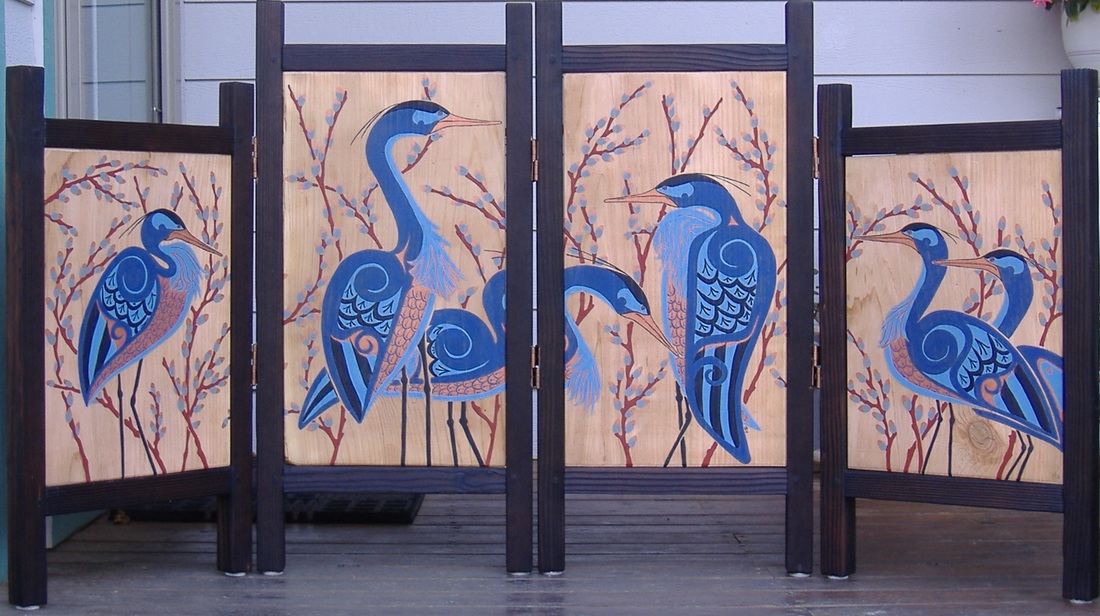Soon after being introduced to the British Arts & Crafts Movement, I began to see examples of screens that caught my attention. These screens were designed to be used as room dividers and /or to reduce the drafty conditions often found in homes at the turn of the last century. Others acted as fire screens to block the draft from a fireplace when not in use. Decorative screens manufactured by Shapland & Petter and those created by designers such as E.A. Taylor and M.H. Baillie Scott enticed me to want to make a similar screen of my own.
|
For a long time, I have been interested in functional art, especially pottery and basketry. These items were designed for a specific use but have an inherent beauty of form and/or design. However, the two most impactful types of functional art that have influenced my painting are boxes and screens. In this discussion screens will be the topic. Northwest Coast Native interior house screens, either painted on cedar boards or on cloth, had the earliest effect on developing in me a strong desire to paint. In 1974, while first reading Bill Holm’s classic Northwest Coast Indian Art: An Analysis of Form (©1965), I saw a photo of the famous “Rain Screen” from the Whale House at Klukwan (figure 67, page 83) and was really taken by its beauty, complexity, and power. In 1975, at an exhibition held at the Seattle Art Museum, I saw a nuu-chch-nulth dance screen on cloth whose design, scale, execution, and beauty really grabbed my attention (see Bill Holm and Bill Reid, Indian Art of the Northwest Coast: A Dialogue on Craftsmanship and Aesthetics, ©1975, pages 248-250). I would go on to see many examples of painted interior or dance screens, either in books, at museums, or in use at potlatch/parties in Neah Bay, and they always acted to inspire me to paint. As part of my education. I went on to paint three large (5+ feet by 8 feet) cedar screens, one in nuu-chah-nulth/Makah style, one in kwakwaka'wakw style, and the third in a transitional style. Functionally, dance screens acted to create a separation of worlds. On one side of the screen reality existed, while the other side acted as the source of myth and legend. Dancers would emerge from behind the screen to connect the watchers to that other world. Soon after being introduced to the British Arts & Crafts Movement, I began to see examples of screens that caught my attention. These screens were designed to be used as room dividers and /or to reduce the drafty conditions often found in homes at the turn of the last century. Others acted as fire screens to block the draft from a fireplace when not in use. Decorative screens manufactured by Shapland & Petter and those created by designers such as E.A. Taylor and M.H. Baillie Scott enticed me to want to make a similar screen of my own. I naturally gravitated to Scotland and the Glasgow style when designing my Peacock screen and offer a note of thanks to designers like George Walton and Charles Rennie Mackintosh for the inspiration they provided me. Finally, I became aware of the beautiful painted screens from Japan. Screen were extensively used in Asian homes as room dividers, sliding doors, or to create privacy in a space. Painted screens not only performed these functions but also provided an element of beauty unsurpassed in interior design. Those painted screens by Ogata Korin and the other members of the Rinpa School seem to have the greatest influence on my own screen creations. Free-standing screens, whether folding or singular, are a means to combine function with beauty. A woman once asked me, when looking at one of my paintings, “But what does it do?” It is nice to create something that not only has artistic merit but also has some specific use. To me this is the best of both worlds.
4 Comments
2/25/2020 01:10:15 am
This ggiovane blog has been sharing and making the wonderful thoughts and finding the essential services as well. I know about the site and finding about painting information and great tips.
Reply
4/11/2022 02:42:41 am
I very much appreciate it. Thank you for this excellent article. Keep posting!
Reply
Leave a Reply. |
Gary GiovaneGary Giovane has been studying art since the ‘70s. A graduate of Penn State University (B.S.) & Memphis State (M.A.T.), Gary has been an archeologist, a cook, and a high school science & math teacher. Gary worked on the Fishtown, Ozette, & Indian Island archeological projects before teaching for 23 years in Neah Bay and for 7 years in La Conner. He currently lives and works in La Conner, along with his wife, Leigh. Archives
February 2018
Categories |









 RSS Feed
RSS Feed